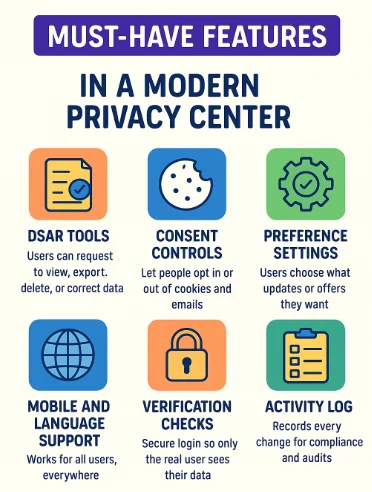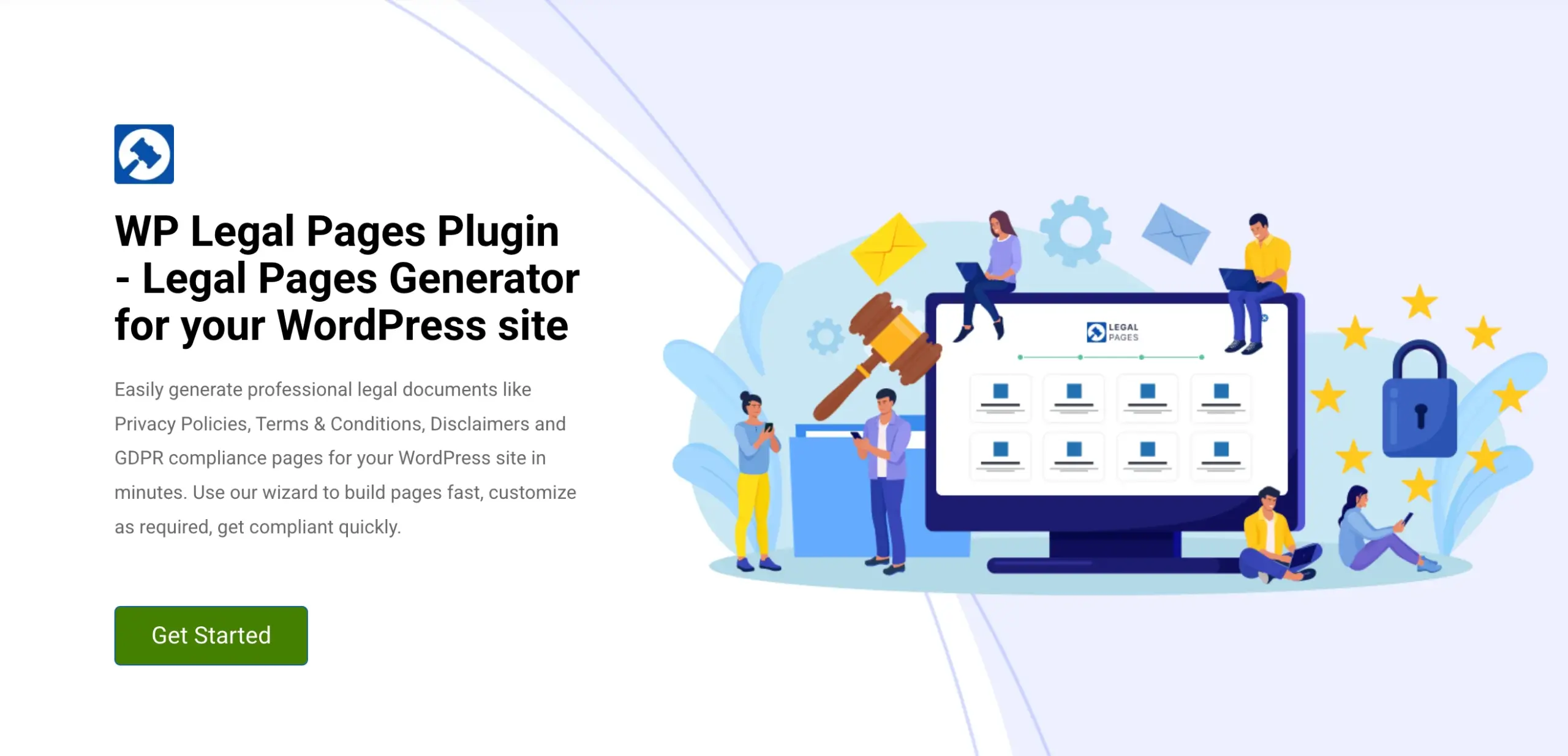Interactive Privacy Centers: Making Compliance User-Friendly

Summary
This article also highlights leading tools and compares options, with a focus on the WPLP Compliance Platform. It demonstrates how businesses can reduce support time, remain compliant, and provide users with more control through a guided wizard and automated compliance logs.
Online privacy is more important than ever. People want to know what happens with their data, and they want control over it.
Think about it: Would your users trust you more if they could see, manage, and control their data rights in just one click? Most would say yes.
That’s why interactive privacy centers are becoming a must. They give people a clear, easy way to manage their privacy choices without reading long, confusing policies.
In this article, we’ll explain what interactive privacy centers are, why they matter, the features they should include, best practices to follow, and how the WPLP Compliance Platform helps you build one on WordPress.
What Is an Interactive Privacy Center?
An interactive privacy center (also called a user privacy dashboard) is like a control panel for your personal data. Instead of just reading a privacy policy, users can take action. They can ask for their data, update choices, or change consent.
This idea is gaining momentum rapidly due to laws such as the GDPR and CCPA, as well as new regulations worldwide. These laws grant individuals more control over their data, and a privacy center facilitates the use of those rights.
Unlike a long privacy page or a simple DSAR form, an interactive privacy center is a self-service portal. That means users do not have to send emails or wait for replies. They can handle many requests themselves, right from the dashboard.
Some standard features include:
- Data requests (DSAR) – Users can request to view, download, or delete their data.
- Consent management – People can give or take back consent for cookies, emails, or tracking.
- Preference updates – Users can choose what type of messages they want to receive.
- Privacy notifications – Quick updates when something changes in your privacy practices.
Benefits of User-Friendly Privacy Centers
Now you might ask: why do I need this? The answer is simple. A privacy center makes life easier for your users and for you.
Here’s what it does:
- Builds Trust: People feel safe when they see you give them control.
- Reduces Risk: You’re less likely to get into trouble with privacy laws, which otherwise will cost hefty fines.
- Saves Time: Users can do things on their own instead of emailing support.
- Cuts Costs: Fewer support tickets mean your team works on bigger things.
- Shows proof: If regulators ask, you can show you already follow the rules.
Must-Have Features in a Modern Privacy Center

Not every privacy center gives the same experience. The best ones are built to make things easy, clear, and safe for both users and businesses.
A robust privacy center should enable users to view and manage their data independently, without requiring support. It should provide them with clear choices regarding cookies, emails, and messages. Users should also have a simple dashboard where they can track their previous activities.
It should work on any device and in different languages, so no one is left out. At the same time, it must keep data secure with proper checks so only the right person can log in.
Additionally, a good privacy center should track every action for compliance purposes and seamlessly integrate with other business tools, such as marketing and CRM.
Best Practices for Building Effective Privacy Centers
A privacy center only works well when it is built with care.

Here are some best practices to follow.
1. Keep it simple
Do not make the privacy center confusing. Use clear words and an easy design so anyone can understand it.
2. Make it easy to find
Do not hide the privacy center deep in the website. Put a link in the footer, menu, or banner so users can reach it in one click.
3. Focus on user control
Give people real choices. Let them manage their data, update preferences, and change consent without sending an email.
4. Use plain language
Avoid legal talk that is hard to read. Write in short and simple sentences so everyone knows what they are doing.
5. Test on all devices
People use phones, tablets, and computers. Make sure the privacy center works smoothly everywhere.
6. Build trust
Be open about how data is used. Show updates, keep records, and always protect user information.
Interactive Privacy Centers in WordPress: Tools and Plugins
When people visit a website, they want to feel safe. They want to know how their data is used and that they have some control. A privacy center is the place where they can see all this in one spot.
If you have a WordPress site, you don’t need to build a privacy center from scratch. There are plugins and tools that can do it for you. Let’s look at some of them and then see why the WPLP Compliance Platform is special.
Tools and Plugins for Privacy Centers
- Complianz – Helps with cookie banners and rules for different countries.
- CookieYes – Good for showing cookie banners and giving users basic choices.
- Termly – Offers banners and privacy policies, but the privacy center part is limited.
These tools are helpful, but most of them focus only on cookies or policies. A real privacy center needs more than that.
Why WPLP Compliance Platform is Different

The WPLP Compliance Platform gives you a full privacy center inside WordPress. It is simple to use and comes with everything you need.
Here are the main benefits:
1. Guided Privacy Center Builder
You don’t have to figure things out on your own. The plugin guides you step by step and creates the page for you.
2. DSAR Portal and Preferences
Visitors can ask to see, download, delete, or fix their data. They can also set their cookie and email preferences with ease.
3. Works with Consent Tools
The privacy center connects with cookie banners and consent logs automatically. No extra setup is needed.
4. Branding and Design Options
You can make the privacy center look like part of your site. Add your logo, colors, and style so it matches your brand.
5. Easy Export for Reports
Need proof for an audit? You can download user logs and data requests in one click.
6. Automatic Log Updates
The plugin keeps consent and request logs safe, updates them when rules change, and makes sure you stay compliant.
Real-World Examples and Scenarios
Let’s take an example of a real-world scenario.
One small WordPress business was getting a lot of emails from users asking about their data. Every request took time to handle because the team had to check, confirm, and reply manually. After adding an interactive privacy center with WPLP Compliance Platform, they cut support time by 70%.
Now users can log in, request their data, and even delete or change it without sending long emails. The team saved hours each week and also built more trust with their audience.
User Journey in WPLP
Here’s how a normal user might use the privacy center:
- Request data access
The user clicks the privacy center link on the website. They log in and request a copy of their personal data. The system prepares a secure file for them. - Change preferences
From the same page, they update what emails or notifications they want to get. For example, they might turn off product updates but keep discount offers. - Withdraw consent
If the user no longer wants certain cookies or emails, they can simply toggle them off. The system updates its consent log automatically. - Confirmation
The user gets a clear confirmation message and can see the history of changes in their dashboard.
This flow shows how WPLP makes privacy simple for both users and site owners. Instead of messy back-and-forth emails, everything happens in one place with just a few clicks.
FAQ
An interactive privacy center is a page on your website where people can control their personal data. It lets users request access, download their data, change email or cookie preferences, and manage consent—all in one secure place.
Yes, if your site collects user data, a privacy dashboard builds trust and makes compliance easier. It saves time by giving users self-service tools instead of handling requests through email. For WordPress sites, plugins like WPLP Compliance Platform make setup simple.
A good DSAR (Data Subject Access Request) portal should include:
1. A way to request, view, and download personal data
2. Tools to correct or delete data
3. Secure login for verification
4. An activity log showing request history
WPLP Compliance Platform gives WordPress users a guided privacy center builder. It includes an out-of-the-box DSAR portal, consent and preference controls, and easy export tools for audits. Users can manage their data on their own, and site owners save time on support.
Privacy laws like GDPR and CCPA expect websites to give people easy access to their data and choices. While a privacy center is not always named as a requirement, it is the simplest way to meet rules for access, consent, and transparency. Many businesses use it as a best practice to stay compliant.
Conclusion
Privacy is something every individual cares about. A strong privacy center gives people control over their data and makes them feel safe on your site.
On WordPress, the WPLP Compliance Platform makes this simple. It comes with ready tools like a DSAR portal, consent logs, and easy preference settings.
This saves time for businesses and keeps them compliant with privacy laws. At the same time, it builds trust because visitors know their choices matter.
Trust is the foundation of every online relationship. Start building your own privacy center today with WPLP and show users their privacy always comes first.
Liked reading this article, check out our other similar articles:
- How to Prepare Your WordPress Site for the End of Third-Party Cookies
- Consent Audit and Logging: Best Practices & Tools for Compliance
- Cookie Consent Best Practices: Simplify Compliance With WPLP Platform
Want to comply with global privacy laws like GDPR and CCPA? Grab the WPLP Compliance Platform now!
